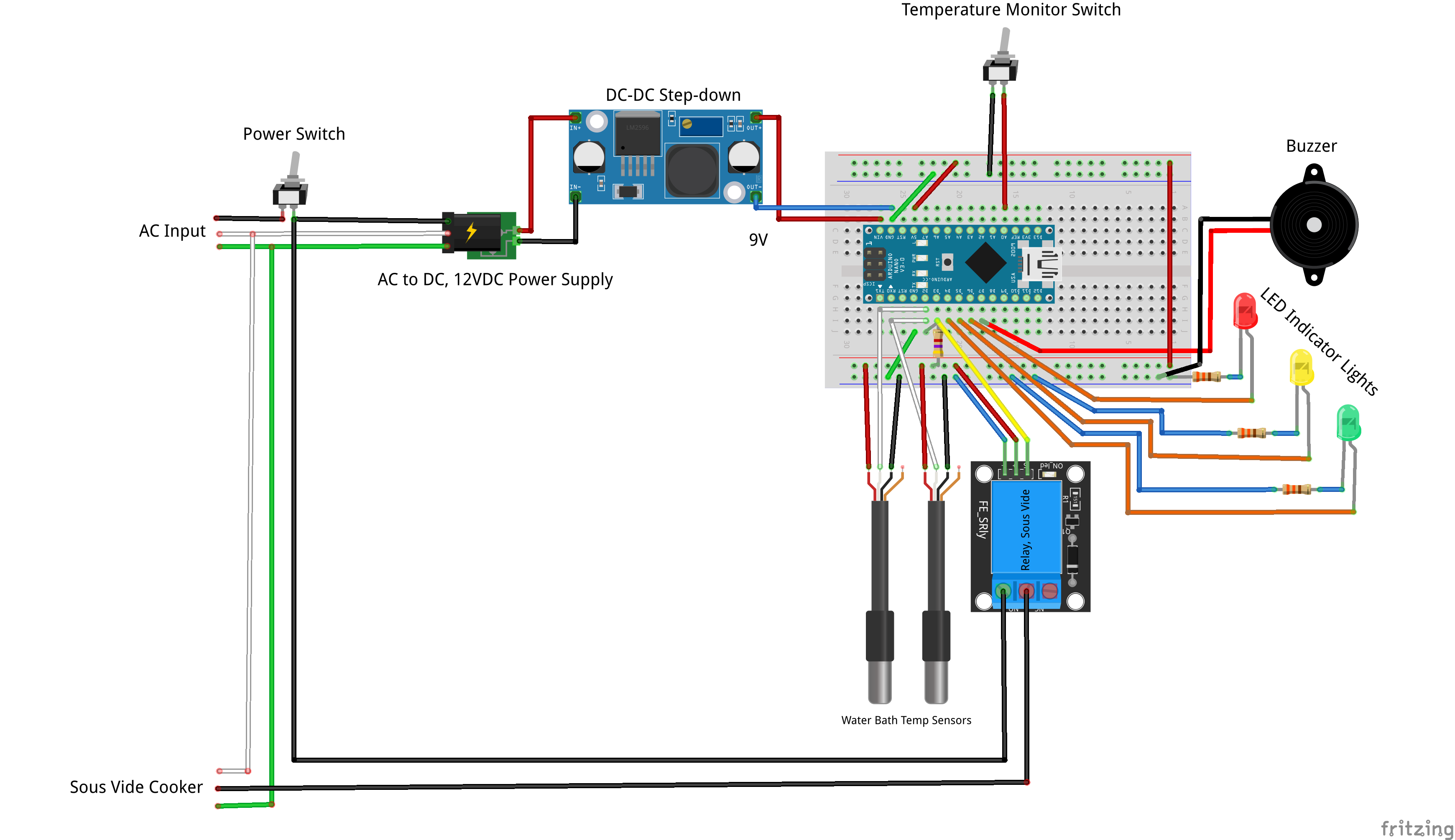
For the new OpenFluidWarmer architecture, the electronics monitor the water bath, alert the user of state and faults, and disconnect the sous vide cooker in the event of a high temperature fault. The new architecture requires fewer electronics components than the previous two hot plate architecture because those components are standard offering in sous vide cookers.
The idea is to package all the electronics in a single enclosure that will be mounted near the sous vide cooker.
Theory of operation is as follows:
- user plugs in the unit into an AC source. If the power switch is in the "off" position, nothing happens. If the power switch is already in the "on" position, see step 2.
- user flips the power switch to the on position. The microcontroller gets powered. If the temperature monitor switch is in the "off" position, the microcontroller commands the relay to close. Closing the relay, provides power to the sous vide cooker. At the same time, the buzzer sounds and yellow LED flashes once a second; indicating that the device is in a warm-up state.
- using the controls on the sous vide cooker, the user sets the temperature and starts the device. Temperature is set based on the IV fluid flow rate. The buzzer sounds and yellow LED flashes once a second; indicating that the device is still in a warm-up state.
- once the sous vide cooker warms the water bath to the temperature set point, the user flips the temperature monitor switch to the "on" position. The buzzer turns off the and the yellow LED stops flashing. The green LED turns on solid; indicating that the device is warmed up and ready to be used. At this point, the microcontroller will be reading the temperature sensors and ensuring that temperatures do not significantly deviate in either direction starting from the moment that the temperature monitor switch was flipped to the "on" position.
- user submerges the appropriate length of IV tubing in the water bath and starts administering the IV fluid/blood product to the patient. If the temperature measured is too far above the set point, the red LED will flash, the buzzer will sound, the relay will open, and sous vide cooker will no longer receive power. If the temperature measured is too far below the set point, the red LED will flash and buzzer will sound. Then it will be up to the medical professional recognize that there is a fault and either turn off the device or allow it to continue operating.
- user removes the IV tubing from the water bath and flips the power switch to the "off" position when finished.
Couple of other thoughts:
- I am thinking of staggering the water bath temperature sensors at different heights in the water bath. Then track the temperature difference between the two sensors. If the temperature difference is too high, that indicates that either the temperature bath is not at a uniform temperature or one of the sensors is out of the water because the water level is too low. At least one water bath temperature sensor should be positioned at either the minimum water level required for the sous vide cooker or minimum water level required to submerge the IV tubing (whichever is greater) to ensure proper water level is maintained.
- After writing about many of the fault scenarios above, it's clear to me now that three colored LEDs is not sufficient to effectively communicate device state and faults to the user. Whatever is considered next needs to have more resolution, but also be able to be clearly read/understood from 1.5m away.
- My intention is to use a Arduino Uno microcontroller instead of the Nano depicted. The 5V pin on the Nano can only supply up to 50mA. Whereas the Uno can supply up to 500mA at the 5V pin. The 5V relay draws about 70mA. I could stay with the Nano if I added another DC-DC step down and tuned it to 5V, but the combined cost of the extra step-down and Nano is more than what I purchase an Uno for. Ideally, I would get rid of the 12V to 9V DC-DC step down. But it is my understanding that the voltage regulator on the Uno can only supply something close to 100mA at 12V input voltage. I had a voltage regulator blow on a Nano recently when powering it at 12V so I am wary of doing that again.
- I wonder how many times the cheap relay module will open under the load of the sous vide cooker during fault conditions.
 John Opsahl
John Opsahl
Discussions
Become a Hackaday.io Member
Create an account to leave a comment. Already have an account? Log In.